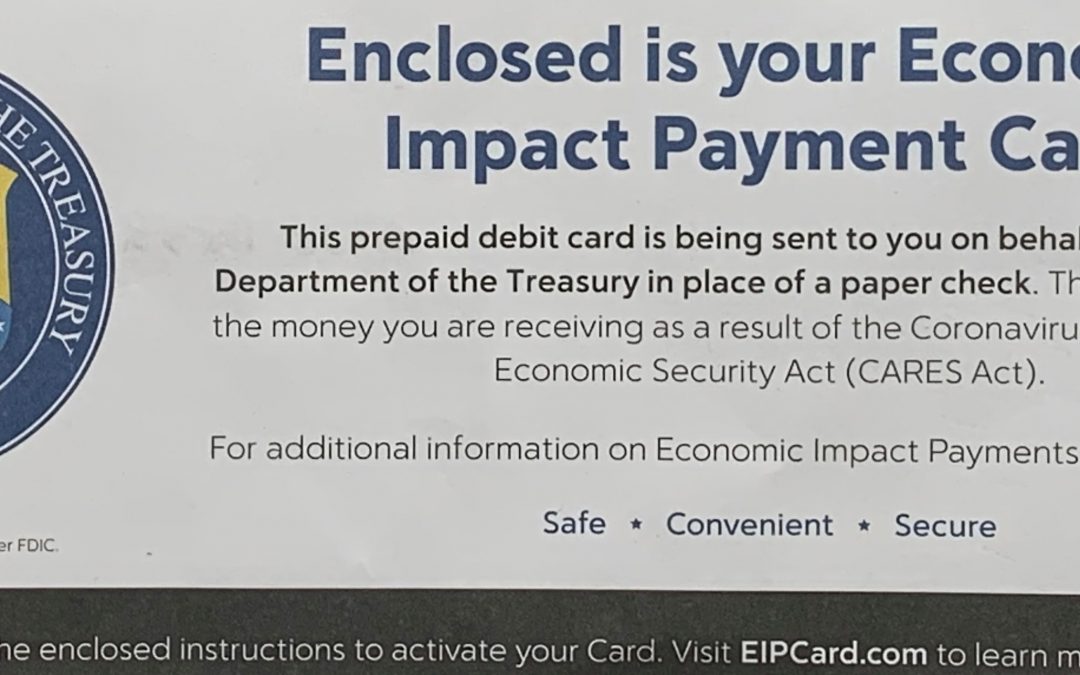And How to Move the Funds to Your Bank Account
Our economic impact stimulus check arrived as a prepaid debit card. As soon as I opened the envelope, I thought, “Is this a scam?” Several things made me skeptical:
- I was expecting a standard US Treasury paper check. I had not heard or read anything about stimulus checks coming in the form of a prepaid plastic card.
- The card arrived in a non-descript envelope from “Money Network Cardholder Services.” I had never heard of this generic-sounding company.
- My name was incorrect on the card. My first name was followed by my husband’s last name. I don’t use my husband’s family name. Both the IRS and U.S. Treasury have my correct name in their databases.
I immediately searched the internet and confirmed from reliable sources that the debit card was indeed our economic impact payment made available under the $2 trillion Coronavirus Aid, Relief, and Economic Security (CARES) Act.
I also learned I was not alone in my skepticism. Many Americans thought the prepaid debit cards were a scam or junk and threw them out.
Once I confirmed it was real, my next thought was, “I don’t want my stimulus payment in a prepaid debit card!” The card can be used at ATMs and anywhere VISA is accepted, but I didn’t want to keep track of another card, especially one with a potentially high balance.
Fortunately, in the list of “No Cost Services and Transactions” that came with the card, I found “Transfer Funds to a Personal Bank Account” as a free option.
To do this, I went to EIPCard.com and created an account. Setting up online access was the same as setting up an online account with any major credit card company. As I went through this process, I needed to receive one-time verification codes via email and text and enter the codes on the website when prompted.
There was no indication of the card balance in the mailing. Once I was logged in, I could see the card balance – the amount of our Economic Impact Payment. To learn the amount of your economic impact stimulus, you need to either call the customer service number (1-800-240-8100) or set up an online account.
The next step was to activate the card by calling the customer service number.
Once I had the online account set up and the card activated, I could transfer the funds to my bank account. I logged into my new account at EIPCard.com and chose “Move Money.” To transfer the funds, I needed my bank’s routing number and my account number. The EIPCard website shows you where to find these numbers on your checks.
I encountered a dilemma: I needed to enter the account owner’s name. My name was incorrect on the debit card, yet the bank does not have me on my account with my husband’s surname. If I entered my correct name, would the transfer be rejected? If I entered the name on the debit card, would the transfer be rejected? My husband and I have a joint account. I decided to put his name as the account owner.
This worked. The funds were in our bank account within two business days.
This was my adventure with the economic impact prepaid debit card payment. The Washington Post article, Stimulus Prepaid Debit Card is Causing a Lot of Confusion, answers many questions about the cards, including how you can use the card, and what to do if you lost or threw out yours by mistake: You can get a free replacement by calling 800-240-8100. If you don’t have your card with the card number, press through all the options until you reach a live person. The person whose name is listed first on the card should make the call.
This blog is published to provide you with general information only and is not intended to provide specific or comprehensive advice. Money Care, LLC encourages individuals to seek advice from competent professionals when appropriate.
Photo by Money Care, LLC. Blog content is the property of Money Care, LLC, and may not be modified, copied, reproduced, sold, or distributed in any manner or medium without permission.

